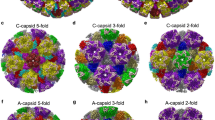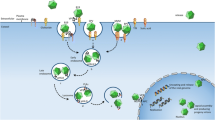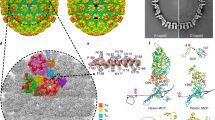Summary
B19 parvovirus is a small single-stranded DNA virus with a genome that encodes only two structural proteins, designated VP1 and VP2. 60 copies of the structural proteins assemble into the viral capsid, with approximately 95% VP2 and 5% VP1. Recombinant empty capsids composed of VP2 alone or of VP2 and VP1 self-assemble into particles that are morphologically indistinguishable from full virions. Empty capsids containing both VP2 and VP1 elicit a strong neutralizing antibody response when used to immunize rabbits. Capsids containing only VP2 are similarly antigenic but elicit only weak neutralizing activity. We performed fine structure epitope mapping by measuring the reactivity of antisera raised against capsids composed of VP2 and VP1 or VP2 alone against 85 overlapping peptides spanning the sequence of the two structural proteins. A profile of the antigenic difference between empty capsids with and without VP1 was produced from the resulting data. This profile divided the sequence of the structural proteins into four regions that correlated well with expected viral structures. Thus, the addition of a small number of VP1 residues altered the antigenicity of the entire capsid. The major area of enhanced antigenicity is homologous to the spike of canine parvovirus, an area known to contain both neutralizing and host-range determinants. Our data are consistent with a model in which the unique region of VP1 is necessary for the virus to assume its mature capsid conformation.
Similar content being viewed by others
References
Brown CS, Salimans MM, Noteborn MH, Weiland HT (1990) Antigenic parvovirus B19 coat proteins VP1 and VP2 produced in large quantities in a baculovirus expression system. Virus Res 15: 197–211
Carlstein E (1988) Nonparametric change-point estimation. Ann Statistics 16: 188–197
Carter BJ, Tattersall PJ (1991) In: Nermut MV, Stevens AC (eds) Animal virus structure. Elsevier, New York, pp 325–334
Fricks CE, Hogle JM (1990) Cell-induced conformational change in poliovirus: externalization of the amino terminus. J Virol 64: 1934–1945
Geysen HM, Meloen RH, Barteling SJ (1984) Use of peptide synthesis to probe viral antigens for epitopes to a resolution of a single amino acid. Proc Natl Acad Sci USA 18: 3998–4002
Kajigaya S, Fujii H, Field AM, Anderson S, Rosenfeld S, Anderson LJ, Shimada T, Young NS (1991) Self-assembled B19 parvovirus capsids, produced in a baculovirus system, are antigenically and immunogenically similar to native virions. Proc Natl Acad Sci USA 88: 4646–4650
Kajigaya S, Shimada T, Fujita S, Young NS (1989) A genetically engineered cell line that produces empty capsids of B19 (human) parvovirus. Proc Natl Acad Sci USA 86: 7601–7605
Kurtzman GJ, Cohen BJ, Field AM, Oseas R, Blaese RM, Young NS (1989) Immune response to B19 parvovirus and an antibody defect in persistent viral infection. J Clin Invest 84: 1114–1123
Ozawa K, Ayub J, Hao YS, Kurtzman G, Shimada T, Young N (1987) Novel transcription map for the B19 (human) pathogenic parvovirus. J Virol 61: 2395–2406
Parrish CR, Aquadro CF, Carmichael LE (1988) Canine host range and a specific epitope map along with variant sequences in the capsid protein gene of canine parvovirus and related feline, mink, and raccoon parvoviruses. Virology 166: 293–307
Rosenfeld SJ, Yoshimoto K, Kajigaya S, Anderson S, Young NS, Field A, Warrener P, Bansal G, Collett MS (1992) The unique region of the minor capsid protein of human parvovirus B19 is exposed on the virion surface. J Clin Invest 6: 2023–2029
Saikawa T, Anderson S, Momoeda M, Kajigaya S, Young NS (1993) Neutralizing linear epitopes of B19 parvovirus cluster in the VP1 unique and VP1–VP2 junction regions. J Virol 67: 3004–3009
Sato H, Hirata J, Furukawa M, Kuroda N, Shiraki H, Maeda Y, Okochi K (1991) Identification of the region including the epitope for a monoclonal antibody which can neutralize human parvovirus B19. J Virol 65: 1667–1672
Sato H, Hirata J, Kuroda N, Shiraki H, Maeda Y, Okochi K (1991) Identification and mapping of neutralizing epitopes of human parvovirus B19 by using human antibodies. J Virol 65: 5485–5490
Schwarz TF, Roggendorf M, Deinhardt F (1988) Human parvovirus B19: ELISA and immunoblot assays. J Virol Methods 20: 155–168
Siegel S (1956) Nonparametric statistics. McGraw-Hill, New York
Tsao J, Chapman MS, Agbandje M, Keller W, Smith K, Wu H, Luo M, Smith TJ, Rossmann MG, Compans RW (1991) The three-dimensional structure of canine parvovirus and its functional implications. Science 251: 1456–1464
Yoshimoto K, Rosenfeld S, Frickhofen N, Kennedy D, Hills R, Kajigaya S, Young NS (1991) A second neutralizing epitope of B 19 parvovirus implicates the spike region in the immune response. J Virol 65: 7056–7060
Author information
Authors and Affiliations
Rights and permissions
About this article
Cite this article
Rosenfeld, S.J., Young, N.S., Alling, D. et al. Subunit interaction in B19 parvovirus empty capsids. Archives of Virology 136, 9–18 (1994). https://doi.org/10.1007/BF01538813
Received:
Accepted:
Issue Date:
DOI: https://doi.org/10.1007/BF01538813




